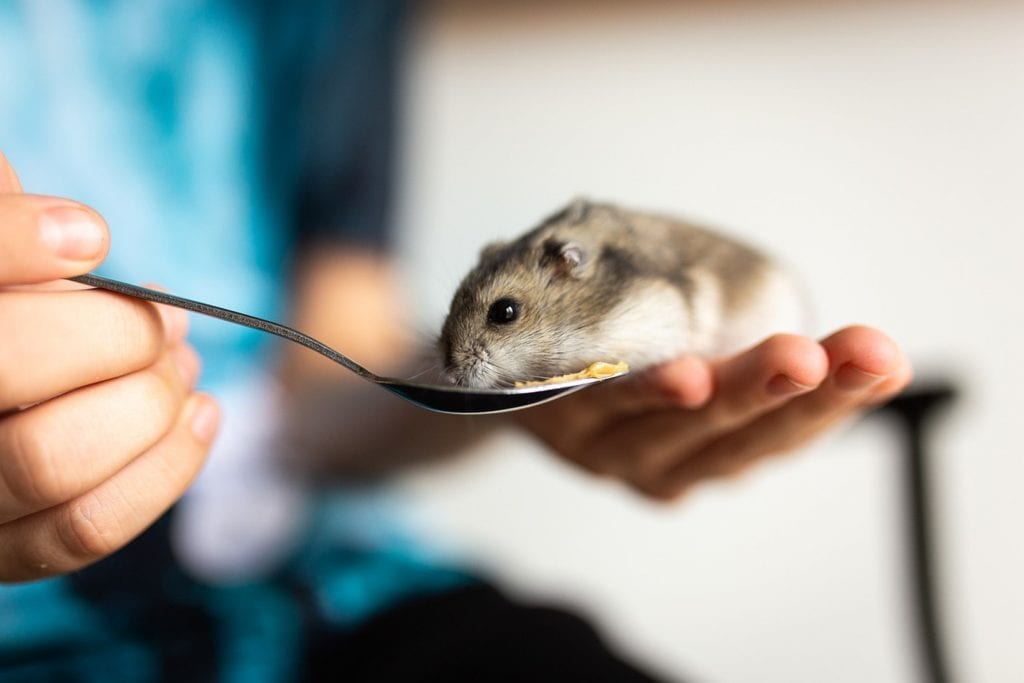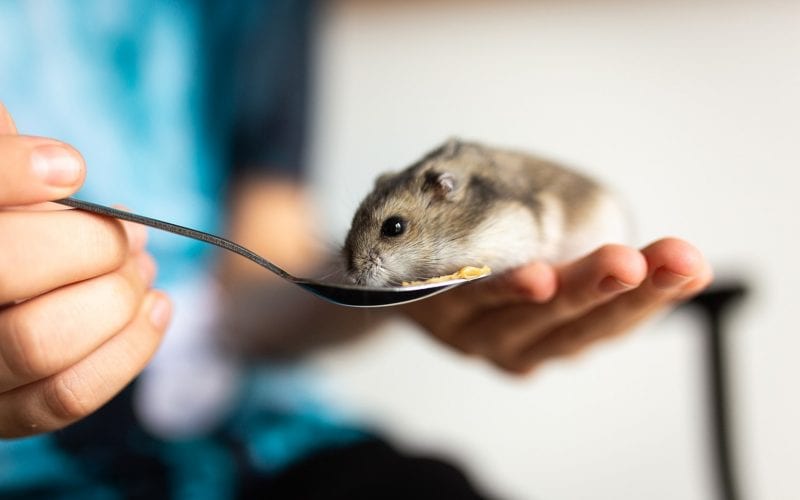
A hamster can be a great pet to have. It is an ideal pet for families who want a low-maintenance pet that doesn’t demand too much attention. A hamster spends most time by itself. It doesn’t require too much attention and can be managed easily. This is why more and more people are getting hamsters as pets. People who live in apartments and find it difficult to keep a dog or cat can keep a hamster. However, you must know that if a hamster gets scared it is likely to bite. It is important to tame the hamster so that it gets adjusted to you. The article tells you how to tame a hamster so it makes a great pet.
Allow the hamster time to adjust
Before going into information on how to tame a hamster, a few preliminaries need to be understood. When your hamster comes home, you must understand that this is a new environment. It will take some time for the hamster to get adjusted to your home. Do not try to tame the hamster at this time. It may turn out to be counterproductive. Give it a few days time to get adjusted to its new home and surroundings. Let the hamster settle down. Once you find that the hamster is eating well and settled down, you can move to the next stage.
Get the hamster’s home ready
Your hamster needs to have a home of its own. Ideally, you need a spacious cage for your hamster. You need comfortable bedding. Use absorbent bedding so the hamster can use the bedding as its toilet. You can clean the bedding daily to prevent a smell. Keep a bowl of water and don’t allow it to stagnate. Let your hamster have both plant and animal-based food. For the first week, just put the food in the cage and don’t attempt to talk to the hamster. Let it get adjusted. Keep a wheel for the hamster to get some play and exercise.
Allow it to recognize your voice
The first thing to do is to allow the hamster to recognize your voice. Do not attempt to touch it immediately, you are likely to be bitten. This is not how to tame a hamster. Talk to the hamster softly. Give your hamster a name. Keep calling your hamster by its name. Keep talking in a soft and firm voice. When you do this daily, the hamster will recognize your voice. Especially, do this while feeding the hamster. This will help the hamster recognize your voice better.
Let it recognize your scent
One of the key techniques on how to tame a hamster is to let it recognize your scent. Hamsters have a great sense of smell. Now that it has learned to recognize your voice, let it recognize your scent. You must know that hamsters have poor vision. Keep your hand in the cage for a few seconds so the hamster can recognize your smell. Keep talking to it while doing this. This will help it associate your voice and scent with you.
IMPORTANT! Wash your hands before putting your hand in the cage. If it smells food, it may even bite.
Tip: Keep your hanky/scarf in the cage, so the hamster can recognize your smell.
Don’t touch it by force
Never touch a hamster forcibly. It can result in a bite. Keep your hand inside the cage and don’t move it around. Allow the hamster to come and smell the hands. Keep talking while doing so. Let the hamster come close and be comfortable enough to climb out on your hand or touch your fingers. Be patient, this is how to tame a hamster effortlessly. Once it is adjusted to one hand, introduce the other hand. Do this a few times a day until the hamster is comfortable.
TIP: If the hamster is startled, don’t pull your hand out, this can scare the hamster.
IMPORTANT! Don’t wake a sleeping hamster to engage with it.

Use a treat to engage with it
Have a special treat for the hamster. Once the above steps are done for a few days, then wash your hand, place a treat on it, and put your hand in the cage. It is very likely that the hamster will climb your hand to take the treat. Else, keep the treat on your fingers and let the hamster eat out of it. Then gradually move the treat to the center of your palm. The hamster should have recognized your smell and will be comfortable. Don’t touch it now. Continue to do this for a couple of days. Let the hamster sit on your hand and eat the treat. The hamster is now adjusted to your hand. Don’t spoil things trying to touch the hamster or pick it up. Be patient!
Gently pick up the hamster
Once your hamster is comfortable eating out of your hand, gently pick it up. Don’t make sudden movements. Lift your hand slightly in the cage. Don’t take the hand yet out of the cage. Wait for the hamster to finish eating and then it should get adjusted to sit on your hand. Do this for a few days. Each day lift your hand a bit higher. Your hamster may jump out of your hand and scurry away. Don’t worry, keep doing this until your hamster is comfortable sitting on your hand.
Tip: If your hamster bites, wear gloves.
IMPORTANT! Don’t close your hand on the hamster, this may scare it.
Take the hamster out of the cage
Once your hamster is adjusted to sitting on your hand take your hand out of the cage. Use your other hand for support so the hamster doesn’t try to jump out and fall on the floor. Sit on the floor near the cage with your hands on your lap and allow the hamster to explore your hands. When you do this regularly, your hamster will start to move on your lap. At this stage, your hamster recognizes you and would be comfortable.
Use a hamster ball
If your hamster is not getting tamed so easily, keep a hamster ball in the cage. You can open the ball and the hamster enters it. Then close it and the hamster will run in it allowing the ball to move. Your hamster will enjoy it. Once your hamster starts playing with the ball, take it out of the cage and keep it on your lap. Open the ball and the hamster is most likely to explore your hands and lap. This is a good technique to tame your hamster.
IMPORTANT! Never leave the hamster in the ball alone. If it feels agitated take it out of the ball and put it back in the cage.
Start playing with it
Once the hamster is comfortable in your hand, you can gently stroke it. You can bring it close to your cheeks and cuddle it. Start playing with it. If you have kids, make them follow the same process to be comfortable with the hamster. Doing all this slowly will allow even the shiest hamster to be comfortable. If you are lucky, you will get a sociable hamster who will adjust to you quickly and play with you. Show love and affection to your hamster and you can tame it easily.
Allow the hamster time out of the cage
Unlike most pets, the hamster is happy in its cage and may even become uncomfortable out of the cage. Allow yourself to bond with the hamster before taking it out of the cage. First, keep it on your lap and then slowly allow it on the floor and stay close to it. Doing this makes your hamster more comfortable and is adjusted to it. Follow a routine by daily taking out your hamster after feeding it and allowing some time out of the cage.
Tips on taming your hamster
- Never try to bypass any of these steps. If you have kids, they may be in a hurry to start playing with the hamster. Don’t do things in a hurry, it can end with your hamster being permanently scared.
- Syrian hamsters are common pets and they are easy to handle. Dwarf hamsters are smaller and faster. You need to be more careful with this breed.
- Never hold the hamster tightly, you may unknowingly crush it. This happens more with children.
- Don’t hold the hamster high in the air, it may fall off from a height resulting in an injury.
- If your hamster urinates on your hand or fidgets/hisses/screams, it is nervous. Put it back in the cage and continue some other time.
- The ideal age to tame a hamster is when it 3-4 weeks old. Older hamsters can also be tamed but need more time.
- Hamsters are territorial, don’t keep another hamster or animal in one cage with it.
The article on how to tame a hamster gave you detailed step-by-step instructions to tame your hamster. Follow these instructions and enjoy playing with your pet hamster.








